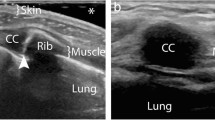Abstract
We have assessed the effect of 10∶1 lossy (JPEG) compression on six board-certified radiologists’ ability to detect three commonly seen abnormalities on chest radiographs. The study radiographs included 150 chest radiographs with one of four diagnoses: normal (n=101), pulmonary nodule (n=19), interstitial lung disease (n=19), and pneumothorax (n=11). Before compression, these images were printed on laser film and interpreted in a blinded fashion by six radiologists. Following an 8-week interval, the images were reinterpreted on an image display workstation after undergoing 10∶1 lossy compression. The results for the compressed images were compared with those of the uncompressed images using receiver operating characteristic (ROC) analyses. For five of six readers, the diagnostic accuracy was higher for the uncompressed images than for the compressed images, but the difference was not significant (P>.1111). Combined readings for the uncompressed images were also more accurate when compared with the compressed images, but this difference was also not significant (P=.1430). The sensitivity, specificity, and accuracy values were 81.5%, 89.2%, and 86.7% for the compressed images, respectively, as compared with 78.9%, 94.5%, and 89.3% for the uncompressed images. There was no correlation between the readers’ accuracy and their experience with soft-copy interpretation; the extent of radiographic interpretation experience had no correlation with overall interpretation accuracy. In conclusion, five of six radiologists had a higher diagnostic accuracy when interpreting uncompressed chest radiographs versus the same images modified by 10∶1 lossy compression, but this difference was not statistically significant.
Similar content being viewed by others
References
Ishigaki T, Sakuma S, Ikeda M, et al: Clinical evaluation of irreversible image compression: Analysis of chest imaging with computed radiography. Radiology 75:739–794, 1990
Mori T, Nakata H: Irreversible data compression in chest imaging using computed radiography: An evaluation. J Thorac Imaging 9:23–30, 1994
Cox GG, Cook LT, Insana MF, et al: The effects of lossy compression on the detection of subtle pulmonary nodules. Med Phys 23:127–132, 1996
Parisi SB, Mogel GT, Dominguez R, et al: The effect of 10:1 compression and soft copy interpretation on the chest radiographs of premature neonates with reference to their possible application in teleradiology. Eur Radiol 8:141–143, 1998
Erickson BJ, Manduca A, Persons KR, et al: Evaluation of irreversible compression of digitized posterior-anterior chest radiographs. J Digit Imaging 10:97–102, 1997
Savcenko V, Erickson BJ, Palisson PM, et al: Detection of subtle abnormalities on chest radiographs after irreversible compression. Radiology 206:609–616, 1998
MacMahon H, Doi K, Sanada S, et al: Data compression: Effect on diagnostic accuracy in digital chest radiography. Radiology 178:175–179, 1991
Lyriboz TA, Zudoski MJ, Hopper KD, et al: A comparison of wavelet and Joint Photographic Experts Group lossy compression methods applied to medical images. J Digit Imaging 12:14–17, 1999 (suppl 1)
Swets JA: ROC analysis applied to the evaluation of medical imaging techniques. Invest Radiol 14:109–121, 199
Metz CE: Some practical issues of experimental design and data analysis in radiological ROC studies. Invest Radiol 24:234–245, 1989
Kido S, Ikezoe J, Kondoh H, et al: Detection of subtle interstitial abnormalities of the lungs on digitized chest radiographs: Acceptable data compression ratios. AJR 167:111–115, 1996
Author information
Authors and Affiliations
Corresponding author
Rights and permissions
About this article
Cite this article
Beall, D.P., Shelton, P.D., Kinsey, T.V. et al. Image compression and chest radiograph interpretation: Image perception comparison between uncompressed chest radiographs and chest radiographs stored using 10∶1 JPEG compression. J Digit Imaging 13 (Suppl 1), 33–38 (2000). https://doi.org/10.1007/BF03167620
Issue Date:
DOI: https://doi.org/10.1007/BF03167620




